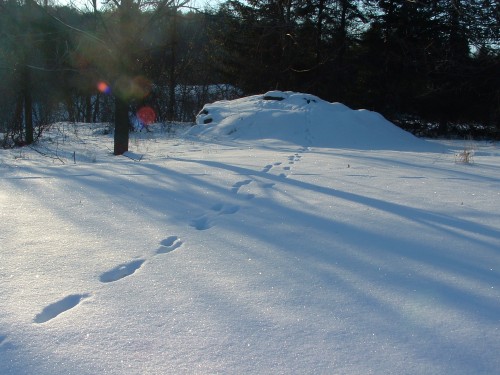|
|
|
WINTER
POPULATION MONITORING |
|
Weeks
13: January 23-29, 2007 |
Welcome
to the McGill Bird Observatory weekly report. Click
here for a complete listing of our archives. Comments or questions are welcome at mbo@migrationresearch.org.
|
PICTURE OF
THE WEEK: |
|

These mammal (either coyote or fox) tracks leading into the
snake hibernaculum near the
front gate are the only signs that these wild canines are
present at MBO. Although
widespread (foxes) and on the increase (coyotes) on the island
of Montreal, both
species are remarkably adept at staying out of sight.
(Photo by Shawn Craik)
-
|
| |
THIS
WEEK |
THIS
WINTER |
2007
TOTAL |
SITE
TOTAL |
| #
birds (and species) banded |
-- |
76 (9) |
14 (4) |
9332 (96) |
| #
birds (and species) repeat |
-- |
26 (6) |
5 (2) |
1554 (52) |
| #
birds (and species) return |
-- |
5 (1) |
2 (1) |
202
(26) |
| #
species observed |
9 |
48 |
24 |
180 |
| #
net hours |
-- |
81.0 |
15.0 |
14037.8 |
| #
birds banded / 100 net hours |
-- |
93.9 |
93.3 |
66.5 |
|
|
Note: table does
not include nocturnal banding (owls) |
Observer:
Shawn Craik
Notes:
Another week has passed where the mercury in the thermometer has held
pretty steady at -15 degrees Celsius (or thereabouts) throughout the
day, meaning it has remained far too cold for banding. Otherwise
the weather has been beautiful, with sunshine virtually every day,
making for great hiking conditions. A walk around the site
produced the above photo, as well as evidence of other mammals,
including white-tailed deer and squirrel. Although the Northern
Shrike was not observed this week, a Sharp-shinned Hawk and Cooper's
Hawk were seen perched near the pond and front gate, respectively.
The feeders have been attracting the usual
suspects including Black-capped Chickadees, Slate-coloured Juncos, and
American Tree Sparrows. A highlight included a pair of
White-breasted Nuthatches feeding in the forest along the road leading
to the cabin. Finch activity was considerably slower this week.
McGill University's undergraduate ethology
class participated in a bird feeder laboratory at MBO on Tuesday and
Wednesday. The goal of the lab was to determine whether
Black-capped Chickadees prefer to feed on black oil sunflower,
grey-striped sunflower, or safflower seeds. Each food type was
presented in a different feeder. Stay tuned for results.
|

